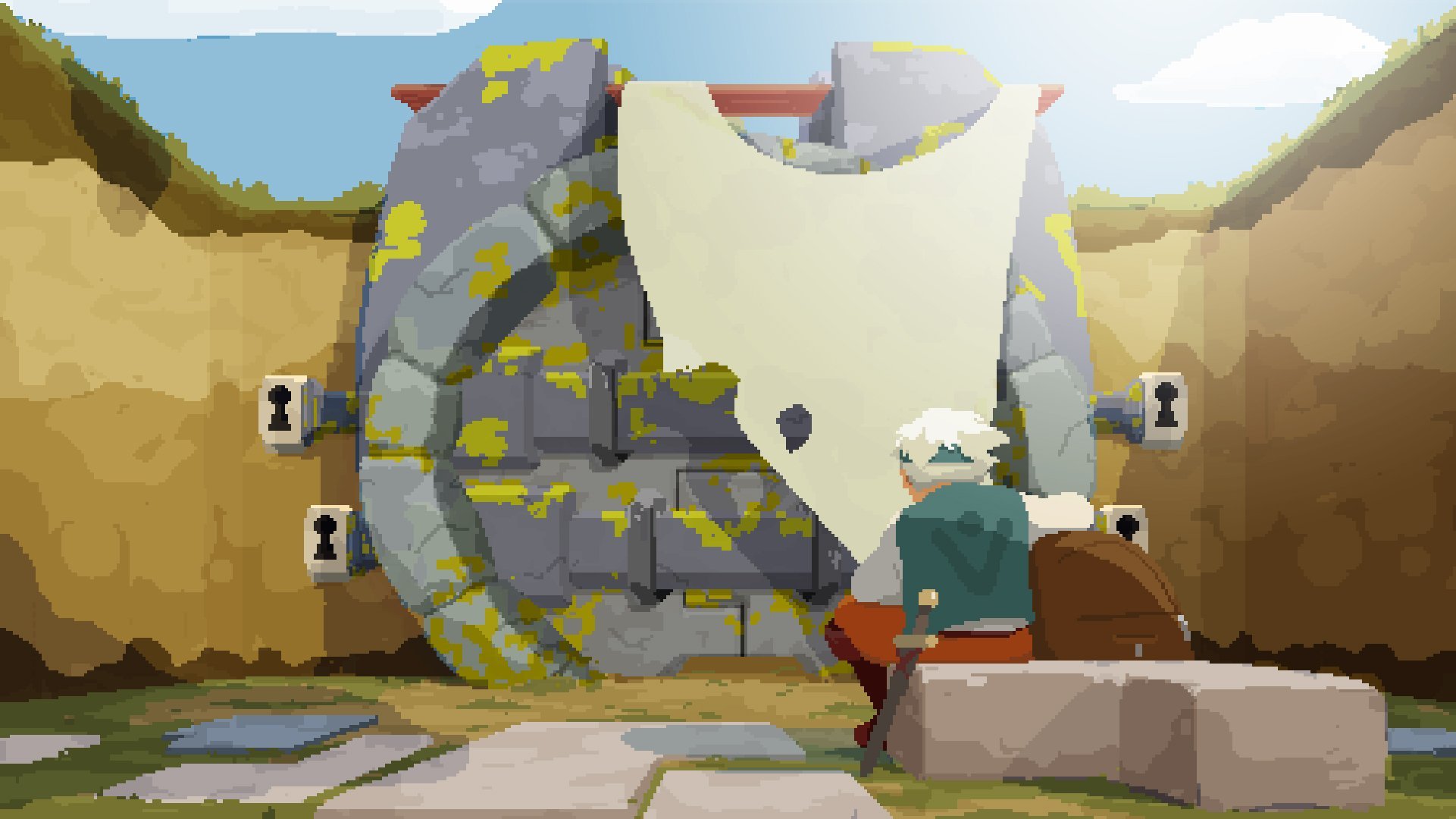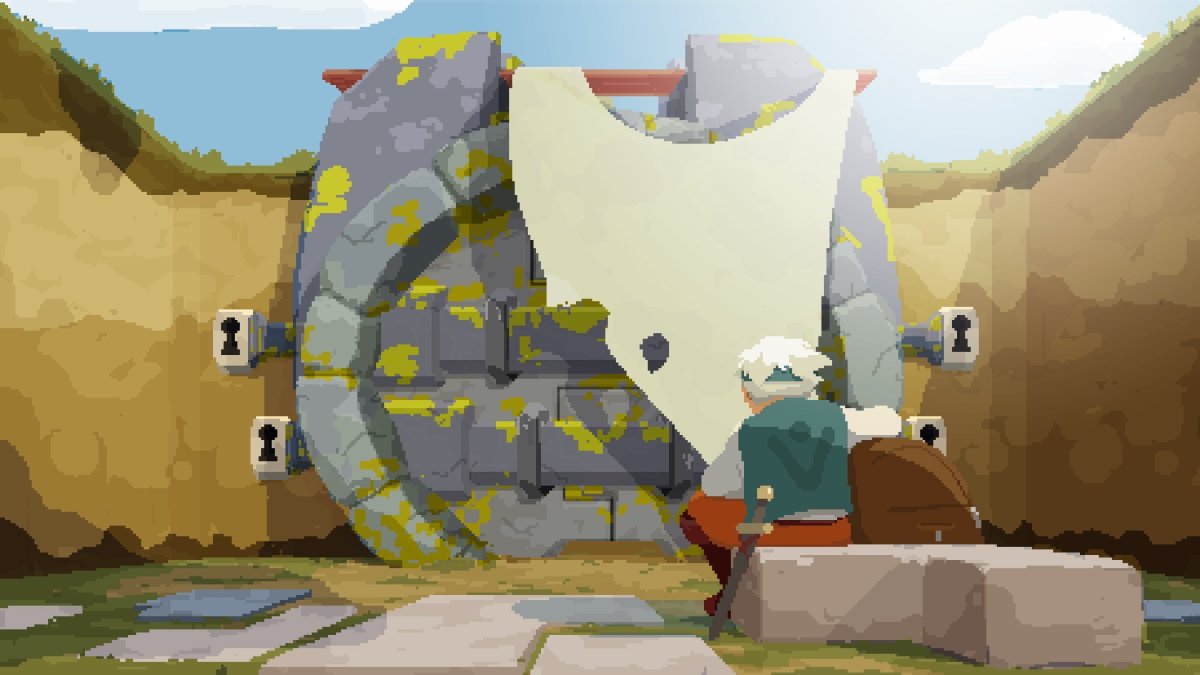An Item Shop’s Tale
I once read an article that some teachers are feeling forced to moonlight and take second jobs to supplement their low teaching salaries. As a teacher, it made me a bit sad to read, especially since I know other professions are in the same boat. Since when is having a career not enough?
Actually, now that I think about it, I’m not really sure that the main character in Moonlighter is actually moonlighting. He heads into the dungeon to get the goods he sells in his own shop — isn’t that the same job, and he’s just cutting out the middleman? Maybe this game should be called Middleman.

Moonlighter (PlayStation 4, Xbox One, Windows [reviewed])
Developer: Digital Sun
Publisher: 11 bit studios
MSRP: $19.99
Release Date: May 29, 2018
I generally tend to avoid directly comparing two games when I write reviews, as I try to focus on what makes this specific game great or not-so-great. That being said, holy cow if you’ve ever played Recettear: An Item Shop’s Tale, Moonlighter is almost identical. You play as an adventurer-merchant who heads into dungeons in order to grab loot and sell it in your shop, earning upgrades on both sides along the way. So if you’ve been looking to scratch that same itch, replacing the anime style with a gorgeous pixel-based one, Moonlighter is for you.
The gameplay loop is rather simple. Enter a dungeon, kill stuff, grab their loot, and eventually return to town to both sell the loot and use it to upgrade your equipment. There are five dungeons in total and they must be tackled in a specific order, though you may return to any completed ones at any time. Each dungeon has three floors and a boss, and you can return to town at any time for a fee.
Returning to town can be achieved in three ways: beating the boss, spending a relatively nominal fee to take a one-way trip back, or spending a large fee to open a portal back that can then be used to return to the same floor and continue on, refreshed and restocked. Given the portal’s cost, I never found it useful. Dungeons are not incredibly long (or difficult), so getting through a dungeon in one shot is just a matter of time and preparation.
There are five weapon types to choose from: sword and shield, big sword, spear, gloves, and bows. Both have two upgrade trees, with one favoring raw damage and the other favoring elemental damage. Trying out the various types, it was clear to me that spears were clearly the best. Incredible range, pretty fast attack speed, and great damage.
The big swords were too clunky to use, and the other melee weapons had such a short range. The bow has its uses, but never enough uses to justify having it. Players can swap between two weapons at will in a dungeon; I’d bring an un-upgraded sword and shield for its blocking capabilities, but still never used it. It sounded good in theory. The armor can also be upgraded, but unlike the weapons, they don’t visually change — upgrading simply changes the stats to be better, which was upsetting.
The problem with combat is its wonky-ass hitboxes. The sword and shield constantly looked like it was hitting during the swing arc, only to never touch the enemy. The gloves, on the other hand, were nowhere close to an enemy and would be punching their lights out, often in some random diagonal direction. The spear feels the best but still has some wonky diagonal-hitting shenanigans going on. Plus you can hit things through obstacles (and enemies cannot do this) so I would often stand diagonally offset to an enemy, though a box, and just hit them until they died.
Combat also feels slow and uninteresting. Each weapon has a standard attack and a special attack: the big sword spins, the spear charges, and so on. The standard attack can often combo, but even this was finicky. There were times where both my character and the enemy were not moving, and I would mash out the three-hit standard combo, only to have it succeed one out of three attempts. Considering the third hit does double damage, this was very frustrating.

The bosses are at least well designed and have interesting movements, though the same can’t always be said about standard enemies. The second dungeon felt the hardest based on enemy behavior patterns, while the fourth is one of the easiest. There are so many enemies in the fourth and penultimate dungeon that simply stand there for a long time, allowing our hero to simply wail on them until they die. Again, this is far from interesting.
Outside of combat, the player will be managing their limited inventory slots with the loot they pick up from dead enemies. This is more than a simple “I don’t have enough space!” Tetris game. Each item takes up a single slot and can stack, however, some items are cursed and have certain requirements within the inventory. For example, one item may need to be placed on the upper or bottom rows while another might destroy any item to its left upon returning to town. Cursed items can only stack with the same items with the same curse, so things become tricky very fast. Luckily, a little device will sell items for you while in the dungeon, though the profit is not the same as selling in the store.
This was a genuinely intriguing take on inventory management that I appreciated. It forces a lot of interesting decisions and creates a new field of useful information. What items sell better at the store? Do I really need to carry another stack of these at all? Are items that are used for crafting more important than items used only for selling? Is it worth teleporting back home with the items I have now, or should I continue? I never thought inventory management would be one of my highlights of a game, but here we are.

Heading back to town allows one to sell their goods in their store, the eponymous Moonlighter. There are limited areas to place the items, though more are added as the store is upgraded. It is up to the player to set the prices and to restock the shelves, as well as catch thieves. Customers enter the store, browse around, and give reactions to the prices. If something is too high, they’ll be sad. If it’s just too high, they may buy it anyway. If it’s hella cheap, they’ll get excited, but if the price is perfect, they are content. These reactions pop up in speech bubbles as they browse, but luckily the game logs which prices gave which reactions. The player’s job is to watch this carefully and adjust accordingly to maximize profit.
Supply and demand is also a big factor. If our intrepid shopkeep has flooded the market with a certain item, customers are not going to pay a penny more than the default price — they may even not pay that much! However, if something is in high demand, you can squeeze a few more gold out of the customer than normal. It takes a bit to get going, but selling loot does get rather fast-paced and exciting the bigger the store is. Thieves will come and try to steal goods, though they always look the same and are announced as thieves as they enter, so a lot of the thrill is taken away. If anyone could be a thief at any time, I’d be a little more engaged.
Using the money earned from the shop, the town can be expanded with more stores to aid in this adventure. The weapons merchant, potion lady, and others can be added to the town after certain points in the story. There are a total of five shops, but only three are really useful. The other two are nice to have but mostly irrelevant. I wish I could say that this aspect had a Dark Cloud vibe to it, but it’s really just unlocking shops and that’s it. The bustling town never really felt like it was responding to what I was doing. Sure they say “wow, you’re amazing!” when I talk to them, but other than that they simply walk around aimlessly all the time.
There is a day/night cycle that has some impact, too. During the night, the dungeon is harder but rewards more loot. You also cannot open the store at night or make improvements to the town. Essentially, the game really pushes for you to open the store in the day and enter the dungeon at night. I played on Hard and never had any difficulty with the night dungeons, so there’s no need to be scared off from the difficulty.

What you do need to be scared of is the bugs. I have lost an entire days work on multiple occasions — once within the same play session. The game has crashed on me twice, both times when loading back into town after the second dungeon. After this, I took a break from the game for three days. If I weren’t reviewing it, I might still be on that break. Another time, I closed the shop and became stuck in the store. I couldn’t leave, couldn’t sleep in the bed, nothing. It’s as if the store was still open…but it wasn’t. I had to force the game closed and re-do that day. Its akin to losing an entire day in Stardew Valley or Animal Crossing — at that moment, there’s nothing more defeating.
While I do enjoy the inventory management aspect of Moonlighter, actually navigating the inventory is a nightmare. I played the game on PC with a gamepad and oh my lord, moving things one square at a time, all the time, is miserable. What I wouldn’t give to be able to use the mouse to move things around. Whether in a dungeon or in the shop, there is endless inventory management. Putting one item in another’s place doesn’t swap the latter into your hand, but puts it where the other item was — making looting chests an arduous experience. The whole system just never works like you think it should.
The music is brilliant, echoing the themes of the dungeons perfectly. The music around town, both day and night, is appropriately relaxing and calming. I can’t quite put my finger on it, but the town music was very reminiscent of exploring towns in the SNES and Genesis era; very nostalgic and whimsical. The art is likewise gorgeous, thanks largely to the incredible animations on just about everything. The pixel art is strong and easily conveys what it needs to, but the animations are what make things feel alive.

Moonlighter certainly nails the addictive gameplay loop that made me go to sleep way too late at times. Still, it’s hard to say that any specific moment, aside from maybe the boss battles, really stands out to me. The idea has been executed before with Recettear, and the lackluster combat mechanics and frequent bugs and oddities don’t do the game any favors.
A lot could be tightened up to make the game feel more snappy and responsive in almost every aspect, especially when it comes to moving inventory items. Moonlighter is incredibly captivating on the surface, but there is a lot of frustration just waiting to be uncovered.
[This review is based on a retail build of the game provided by the publisher.]





